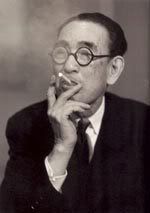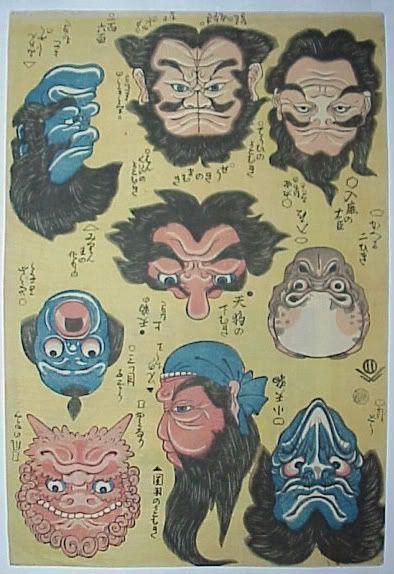As previously discussed, Kuniyoshi had the true spirit of the 'Artist' and did not always conform to the ruling paradigm. He lived during a time of strict government that ruled all aspects of life. Below you will find excerpts from an interview with an author that lived about 100 years after Kuniyoshi, but had a lot of insight about the period.
Nagai Kafu (1879-1959)
Excerpts from an Interview with the illustrious Japanese author Nagai Kafu (1879-1959)
"...
YR: No, I suppose not. In which case let us proceed to another ambiguity. You seem distinctly individualist in philosophical bent and general temperament, and yet you appear to hanker after the Edo period, which was probably even more authoritarian than the Meiji period and all that it ushered in.
NK: Well, this is true. But perhaps that is the fault of my fatalistic nature. I do not admire authoritarianism, by any means. But the problem is one of aesthetics. The arts of Edo, not to mention the architecture and the manners, were far superior to the arts of our ill-considered 20th century. [5] The thing about the tyranny of the past, I suppose, is that it has been an oppressive cloud casting a great shadow, and I’m sure you are aware how fond I am of shadows and what is to be found among them. The ukiyo-e, for instance, for which I harbour almost religious feeling, is just such a product of this tyrannical shadow, the art of the oppressed plebeian, expressing in part resignation and in part defiance. Please note it is not the tyranny, but the resistance to that tyranny with which I am in especial sympathy."
"...
YR: Yes, you’re quite right. Perhaps it is irrelevant. Speaking of which, do you think your work, backward looking even at the time of writing, has any relevance for readers today? Is it even healthy to be reading something that dwells so much on a past irrecoverably lost?
NK: My immediate response is to say that I do not care whether it is relevant to ‘the reader of today,’ or not. I have had occasion to wander the streets of Asakusa, Mukojima, where I set Bokuto Kidan, Fukagawa, Nihombashi – I could go on – and I find that as the city approaches the 21st century, there remains not a shadow of the city I knew and wrote about. I cannot hope to describe the overwhelming sadness that the sight of the modern streets induces in me. There is the sense of a world lost as in the blinking of an eye, and I come to feel the true meaning of what it is to be a ghost. ‘As I witness the extinction of the city’s spirit I feel in all my being nothing but a desire to be gone with it.’ [10] You ask if my works are relevant today, but that is not for me to answer. Why trouble my ghost with these questions? Perhaps it is best to be forgotten, to be perfected by obsolescence, to rest, rather than be called back and called back like this to a present where one does not belong. Let the past be the past and the present be the present. Only one thing – perhaps you should ask yourself why you wished to ask me such a question. I have passed on and such matters do not concern me, but the living are necessarily more restless than the dead. It is the living, perhaps, who are more haunted by the past.
YR: Have you anything to say before you slip once more through the ghostly turnstile to the other side?
NK: Yes. Your last question has set me to thinking. If I might be allowed to quote myself, and whether you act on it or not it is a truth, “I say it unconditionally: Our future has no road to proceed from save that of our past.” [11]
YR: Nagai Kafu, thank you very much for your time.
NK: Thank you.
And somewhat like a Cheshire Cat, Kafu fades away, leaving behind his spectacles and his gap-toothed grin for a moment. "
Directory of Lost Causes (By Quentin S. Crisp)
Shown Below:
A giga print called Ue-shita-e. These designs can be viewed upside down. Depicts various faces including a frog; tengu; the great general Zhanghi in the Three Kingdoms, and the tyrant King Zhou of the Yin Dynasty. Published by Ezakiya Tatsuzo, c 1842. Another impression ( from the Museum of Paper, and attributed to Kuniyoshi ) is illustrated in Edo no Asobi-e, no.2 and back cover. Rare.
upside down:
Saturday, March 8, 2008
Kuniyoshi: Outlaw Artist with commentary about the Edo period from Nagai Kafu
Subscribe to:
Post Comments (Atom)






3 comments:
Hello. Thanks for the link.
By the way, I'm currently writing a novel set in Japan, some of which takes place in the Edo period. I'll probably have to research some of the details, so I've been meaning to ask if you can recommend books or stuff, but I'll need to tell you what things specifically I'm interested in, and I have to give that a bit of thought.
So, I expect I'll be back.
Nice blog, by the way.
Hello. Thanks for the link.
By the way, I'm currently writing a novel set in Japan, some of which takes place in the Edo period. I'll probably have to research some of the details, so I've been meaning to ask if you can recommend books or stuff, but I'll need to tell you what things specifically I'm interested in, and I have to give that a bit of thought.
So, I expect I'll be back.
Nice blog, by the way.
Hey Quentin,
Thanks for comment. I am learning as I go but will be glad to help in any way possible. That was a great article and it fit perfectly with the subject I was writing about. Just let me know when you need help and I'll pitch in.
Thanks!
Post a Comment